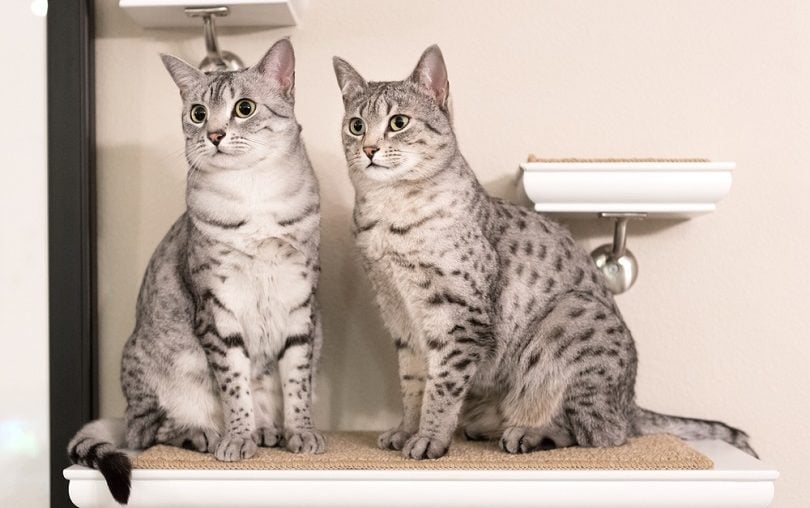
Click to Skip Ahead
If you like a cat that’s a bit on the wild side, the Bengal and Egyptian Mau are two breeds worth the research. One cat has a history dating back to ancient times, whereas the other breed has only existed for about 50 years.
Regardless, both cats are very active and loving creatures with striking colors and patterns. In fact, they almost look like the same cat at first glance. But don’t be fooled; these kitties have their differences worth noting. Let’s dive into what makes these two breeds so different so you can pick out the perfect pet.
Visual Differences

At a Glance
Bengal Overview

To understand a Bengal, it helps to know the Asian Leopard Cat (Prionailurus bengalensis), a small wild cat found across the eastern side of the world. The Asian Leopard Cat is no bigger than a domestic cat but has striking fur patterns, catching the attention of poachers.
Their beautiful exotic fur quickly landed the species on the endangered list. Conservationist Jean Mill decided to do something about it. In 1963, Mill started crossing Asian Leopard Cat and domestic cat genetics. By the 1980s, she created a new breed of cat that looked like an Asian Leopard Cat but had a tamer personality suitable for domestic life.
Personality & Character
If you were to adopt a Bengal, many would say you have a pet leopard roaming your house. Their wild roots mean Bengals are highly energetic cats hungry for exploration. These cats will climb, run, play, and fight more intensely than other house cats.
Without a way to burn this energy, Bengals can become disorderly. Plenty of exercise and mental stimulation can prevent behavior problems, although you might notice some peculiar quirks occasionally. Bengals are known to steal shiny objects and enjoy splashing in water. With Bengals, there’s never a dull day.
Health
Bengals are generally healthy because of their selective breeding. Typical ailments found in all house cats are still common, like obesity and dental disease. Because of their high activity levels, Bengals require more calories than other house cats to meet their nutritional and energy needs.

Grooming & Appearance
Bengal cats are medium-sized cats with leopard-like spots or rosettes. Their markings and fur colors vary in color, such as:
- Rust
- Golden
- Brown
- Chocolate brown
- Black
- Orange
- Sand
- Ivory
Some Bengals even have shimmery fur that glistens under the light.
Bengals have small, round heads, large eyes, and additional facial markings similar to tabby cats. If you look closely, you’ll notice their back legs are longer than their front legs, allowing for a more dominant stride.
Suitable For:
Bengals are demanding and, therefore, require experienced cat owners with time to dedicate to training and exercise.
Egyptian Mau Overview

The Egyptian Mau has no clear records of its history. Still, it competes with the Abyssinian as the direct descendant of ancient Egyptian cats, making it one of the oldest cat breeds in the world. Archaeologists have uncovered remains of cats looking very similar to Egyptian Maus, but we can never know for certain.
However, we can trace the American lineage back to 1956 when the Russian Prince Nathalie Troubetkoy came to the US after being exiled. Since then, the breed has earned its stripes in the country and achieved championship status in 1970.
Personality & Character
Egyptian Maus are perfect for dog-loving families. These cats are loyal and devoted to their owners and will form a bond with other pets over time. They’re not as accepting of new pets right away and will need to do so on their own accord. Over time, they learn to love new family members.
Like Bengals, Egyptian Maus are highly active and require rigorous exercise and mental stimulation. Behavior problems will arise if these needs aren’t met. With lots of playtime and snuggles, Egyptian Maus can fit into almost any family.
Health
Egyptian Maus are one of the most athletic and agile cat breeds. They can leap to 6 feet in the air from their standing position and sprint up to 30 miles per hour. Even so, they take up to 2 years to reach full physical maturity.
Egyptian Maus have no major health concerns but can be prone to obesity and dental disease like other cats. Because of their high energy, Egyptian Maus require more calories to meet their energy requirements.

Grooming & Appearance
Often mistaken for Bengals, Egyptian Maus have sleek and slender bodies with natural spots on the coat and skin. They often sport silver, bronze, or smoke-colored furs.
Egyptian Maus are smaller than Bengals and have almond-shaped eyes and a wedge-shaped head with stripes. The stripes mimic an Egyptian scarab beetle, a holy beetle seen as a symbol of the sun.
Suitable For:
Egyptian Maus make excellent family cats with small children and other pets. Although they need time to adjust to new animals, Egyptian Maus will come to love all household members, including the family dog. Egyptian Maus do best with active families who can set aside time for rigorous play.
Which Breed Is Right for You?
The Egyptian Mau and Bengal are very active cats that require time, attention, and activity from their owners. Egyptian Maus do best in homes with small children and pets and a Bengal does best in a home with older children and no pets, although they can tolerate one or two animals.
Ultimately, the people and pets already present in your home will have a big impact on which cat is best for you.
Featured Image Credit: (T) TheCats, Shutterstock | (B) Jolanta Beinarovica, Shutterstock
The post Bengal vs. Egyptian Mau: The Key Differences (With Pictures) appeared first on Pet Keen.






